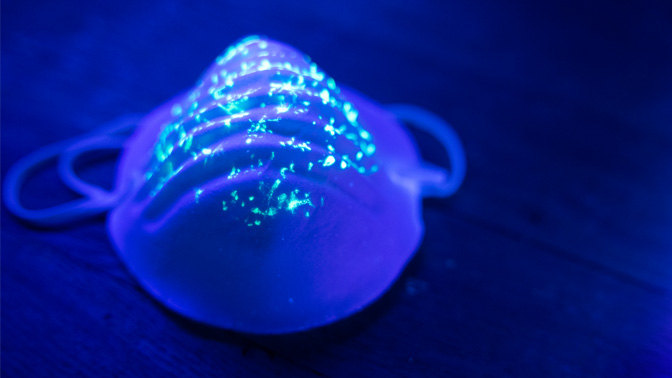
A shortage of personal protective equipment (PPE) has been one of many challenges of the COVID-19 pandemic. In particular, medical grade N95, which can protect healthcare workers and patients during certain procedures, have been in short supply.
One way to help maintain the supply of N95 masks is to re-use them. However, this requires that the masks be safely cleaned and decontaminated. Ultra-violet C (UVC) light can be used to kill germs and decontaminate masks. Because of the speed at which the pandemic spread, many hospitals were under pressure to rapidly develop re-use protocols.
PM Senior Scientist Dr. Lothar Lilge and colleagues recently completed a detailed examination of the performance of UV light for decontamination of N95 masks.
While it was already known that UV sterilization does not affect the performance of an N95 mask, scientists were not yet sure of how well UV light could penetrate through all the layers of a mask.
The team from UHN and the University of Toronto tested samples from seven different N95 masks to determine how UV light penetrates the material and scatters within or off of it. They then created a detailed computer simulation to determine if there were any areas of the masks that may not absorb enough UV light to be properly sterilized. They also tested how different wavelengths of UV light interacted with each mask.
The findings of their research provide the technical specifications required to effectively UV-sterilize N95 masks. For example, the research reveals the best combinations of UV intensity and angles for different materials and mask shapes.
N95 masks often have ink labelling on them (for example, to indicate the model number). The study revealed that this labelling does not impede their ability to be sterilized with UV light. However, they recommended against marking respirators with permanent markers that can penetrate the material.
“By conducting rigorous tests, we’ve identified which UV-based sterilization procedures work and have confirmed that N95 masks can, indeed, be effectively sterilized for reuse,” says Dr. Lilge. “By redirecting our expertise in basic science—specifically in light propagation in oncology—this work is an example of how different disciplines are meeting the immediate needs of the pandemic.”
This work was supported by the Ontario Ministry of Economic Development and Trade through the Ontario Research Fund Grant, the Ontario Ministry of Health, an NSERC/Intel Industrial Research Chair in Programmable Silicon, an IBM Faculty Research Award, and The Princess Margaret Cancer Foundation.
Lilge L, Manalac A, Weersink M, Schwiegelshohn F, Young-Schultz T, Abdalrhman AS, Wang C, Ngan A, Gu FX, Betz V, Hofmann R. Light propagation within N95 filtered face respirators: A simulation study for UVC decontamination. J Biophotonics 2020 Sep 5. doi: 10.1002/jbio.202000232
Update: Further research showed using computer modelling that the sterilization process may not be 100% effective if the UV light cannot reach every part of the mask. Potential solutions to increase the efficacy of the sterilization include rotating the mask while sterilizating or shining UV light on the mask from all directions.
Abdalrhman AS, Wang C, Manalac A, Weersink M, Yassine AA, Betz V, Barbeau B, Lilge L, Hofmann R. Modeling the efficiency of UV at 254 nm for disinfecting the different layers within N95 respirators. J Biophotonics. 2021 Oct. doi: 10.1002/jbio.202100135.




